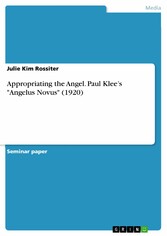Search and Find
Service
Appropriating the Angel. Paul Klee's 'Angelus Novus' (1920)
Seminar paper from the year 2017 in the subject Art - Painting, grade: 80.00, , course: Fine Art Masters Degree, language: English, abstract: This paper shall deconstruct Paul Klee's German Expressionist painting, Angelus Novus (1920), with the objective of contextualizing a modality of balance aesthetic. The process shall then analyse the Pedagogical Sketchbook (1925), transcribed by Paul Klee in 1918, to critically examine a content of pedagogical homeostatic practice methodology, and focus on a diagrammatic construct within the book, Building a Tower (1918). The attention on an analysis of this diagrammatic has the objective of identifying it as a pedagogical homeostasis model, and to evidence this model informing a modality of balance aesthetic for his later painting, Angelus Novus. Paul Klee's pre-1918 practice is then assessed to distinguish trauma related poiesis, in consideration that psychological imbalance may have triggered instigation of homeostatic methodology within Pedagogical Sketchbook. Paul Klee's painting after Building a Tower, shall then be deconstructed as a methodology of considering its practice influence. An overlaying technique will then be used to reinforce this theory of framework connectivity. As a Der Blaue Reiter artist, Paul Klee's art was attributed new significance of 'Entartete Kunst', in 1937 by Adolf Hitler. In this paper, the act of attributing new significance shall be referred to as 'revalorization'. The scholarly theses, Theses on the Philosophy of History (1939), by Walter Benjamin contains the stanza Theses IX, in which Angelus Novus is renamed as the, Angel of History. Within this paper, the act of renaming of Angelus Novus, requisitioned with its form redirected shall be termed as 'appropriation.' The configuration of Theses IX, is inconsistent in both style and structure of main body of the theses. The method of deconstructive critical assessment will be applied to both the variance within the scholarly paper, and the physical form -versus the descriptive text of the appropriated form of Angelus Novus. Assessment of discrepancies will be considered to determine fixity in Walter Benjamin's ability to mediate and communicate rationally. Reflection contextualizing homeostatic disequilibrium, as causation for variance of subjectivity and state of mind, at the time of writing Theses IX are investigated. The conclusion considers the homeostatic ontology, subsequent appropriation and revalorization of Angelus Novus, and the outcome intends to present a unique critical theory informing how the artwork should now be viewed.
All prices incl. VAT












